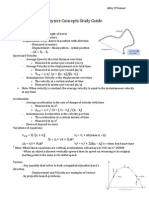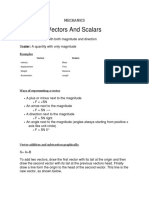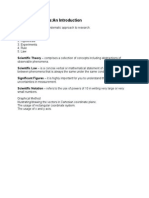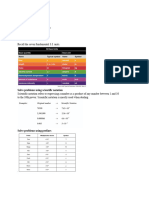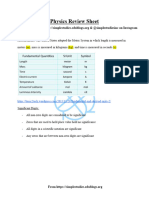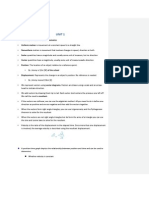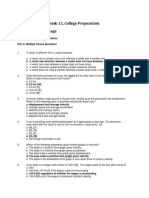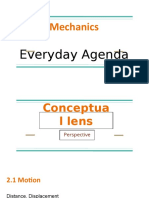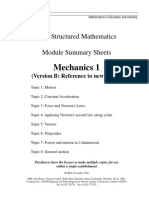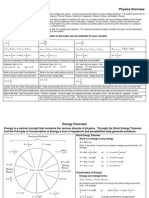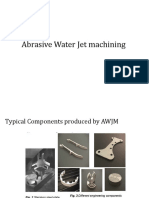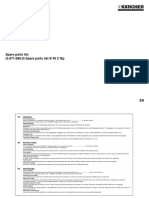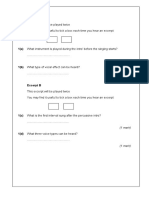Notes
Uploaded by
Asif IrfanNotes
Uploaded by
Asif IrfanlOMoARcPSD|34621763
Notes
Physics 1 (Regular) (University of Sydney)
Scan to open on Studocu
Studocu is not sponsored or endorsed by any college or university
Downloaded by Asif Irfan (asifirfan05@gmail.com)
lOMoARcPSD|34621763
Physics Prelim Notes
Downloaded by Asif Irfan (asifirfan05@gmail.com)
lOMoARcPSD|34621763
Module 1: Kinematics
Motion without forces
Linear Motion:
• Scalar: number e.g. distance, time, energy, speed
• Vector: number and direction e.g. velocity, acceleration, force, displacement
• Standard international units are used to keep consistency:
Measurement S.I. Units
Distance (d) Metres (m)
Displacement (s) Metres (m)
Time (t) Seconds (s)
Speed(v) Metres per second (m/s) (𝑚𝑠 !" )
Velocity (v) Metres per second (m/s) (𝑚𝑠 !" )
Acceleration (a) Metres per second (m/𝑠 # )(𝑚𝑠 !# )
Force (F) Newtons (N) (𝑘𝑔𝑚𝑠 !# )
Temperature Kelvins (K)
• Only forward and back motion, aka + and – motion
• Acceleration is the measure of how an objects velocity is changing over time
Formulas of Motion:
• 𝑣 = 𝑢 + 𝑎𝑡
• 𝑣 ! = 𝑢! + 2𝑎𝑠
"
• 𝑠 = 𝑢𝑡 + ! 𝑎𝑡 !
• Where:
o u=initial velocity
o v= final velocity
o t=time
o s=displacement
o a=acceleration
Downloaded by Asif Irfan (asifirfan05@gmail.com)
lOMoARcPSD|34621763
Motion on a Plane:
• Vectors can be represented as arrows where:
1. The size of the vector is given by the length of the arrow
2. The direction of the vector is given by the direction of the arrow
• If objects are moving in opposite directions, one direction is given a negative sign and the
other a positive
East West Into Page Out of Page
1D Vector Addition:
• To add vectors, we follow 2 steps:
1. “Head to Tail”
2. “Beginning to End”
Resultant Vector
1D Vector Subtraction:
• Mainly happens in questions involving relative motion
• When one object moves relative to another, the words relative to can be replaced with
“minus”
• Vab means the velocity of a relative to b
• To subtract vectors diagrammatically we:
1. Flip the subtracted vector
2. Use vector addition
2D Vector Addition and Subtraction:
• When solving vector problems in 2 dimensions, we need to resort to diagrams
• Resultant = å = sum of
• The steps for vector addition:
1. Connect the vectors head to tail
2. Draw a resultant vector
3. Use Pythagoras to find its length and trig to find the angle, and hence direction
• The steps for vector subtraction:
1. Flip the subtracted vector Resultant Vector
2. Use vector addition
Downloaded by Asif Irfan (asifirfan05@gmail.com)
lOMoARcPSD|34621763
Resolving Vectors:
• Any angular vector can be resolved into one horizontal and one vertical vector
• Trigonometry can then be used to find the length of each resultant vector
𝜃
= 𝜃
Uy
Ux
Graphs:
• A v-t graph is a velocity-time graph • An s-t graph is a distance, but mainly
displacement,-time graph
Gradient Gradient
S Area under Graph
V Area under Graph
A
∆𝑣 𝑣 − 𝑢
𝑎= =
∆𝑡 𝑡
Downloaded by Asif Irfan (asifirfan05@gmail.com)
lOMoARcPSD|34621763
Module 2: Dynamics
Everything about motion of objects that includes their causes (forces)
Reminder: å= “sum of” = a+b+c…
D= “change in” =final – initial
If air resistance isn’t stated, it’s negligible
Newton’s Laws of Motion:
Newton 1: Law of Inertia
• An object at rest will remain at rest unless acted on by an unbalanced force
• An object in motion will remain in motion unless acted on by an unbalance force
• There are 2 reasons why Newton 1 is not obvious on the surface of earth:
o Gravity: pulls down an object at rest and accelerates it
o Friction: slows down an object in motion
Newton 2: åF=ma
• The sum of all forces acting on an object is equal to its acceleration multiplied by its
mass
Newton 3: Every action has an equal and opposite reaction
• For example, pushing on a wall with a force of 30N means the wall is pushing back with
30N
Frames of Reference:
Inertial Frames of Reference: åF=0 Non-Inertial Frames of Reference: åF¹0
• Stationary • Accelerating
• Constant velocity • Decelerating
Static and Dynamic Forces:
• Static forces: When the object is stationary but there are forces acting on it, this means
åF=0
• Dynamic forces: When the object is moving, then the forces acting on it are either:
o åF=0 (Constant velocity)
o åF¹0 (accelerating or decelerating)
Downloaded by Asif Irfan (asifirfan05@gmail.com)
lOMoARcPSD|34621763
Contact vs Field Forces:
• Contact Forces: The force requires contact to have an effect on the motion of the object. Best
example is friction
• Field Forces: The force can have an effect on an object without touching it. There are 3
field forces:
o Gravitational Field (affects anything with mass)
o Electric Field (affects anything with charge)
o Magnetic Field (affects magnetic poles)
A field is an area where a force is applied
A field line is the direction in which the object will experience a force towards:
o Mass for gravitational fields
o Positive charge for electric fields
o North pole for magnetic fields
Uniform
A south pole will fall up the arrows.
Not uniform.
I= Current= Flow of positive wholes.
Plus charge will fall up the arrow
Downloaded by Asif Irfan (asifirfan05@gmail.com)
lOMoARcPSD|34621763
Unlike current, the strength of field lines can’t be shown through length. Instead, it is
shown through the density of the arrow
The main difference between the 3 fields: Gravity only attracts but electric and magnetic
also repel
Ramps:
• An object on a ramp will not accelerate downhill at 9.8ms-2
unless 𝜃 =90°
• 0<adownhill<9.8
• mg=Fg
• N=-F^
#!
• adownhill=
$
• FU=Fgsin 𝜃
• F^=Fgcos 𝜃
Friction:
• Friction always opposes motion
• F=µN where: µs=coefficient of
o F: force required static friction
µD=coefficient of
o µ: Coefficient of friction
dynamic friction
o N: Normal force
• There are two types of friction:
o Static friction
o Dynamic friction (aka kinetic friction)
Static Friction:
• When an object is not moving/sliding it requires a large force to get it to slide. Max force
is static friction
Dynamic Friction:
• Once sliding, a force of smaller value is required to keep it moving. Min force is
dynamic friction
Downloaded by Asif Irfan (asifirfan05@gmail.com)
lOMoARcPSD|34621763
Work:
• The amount of energy transfer that occurs when an object is moved over a certain
distance by an external force (only force in direction of displacement is considered)
• W=Fs where:
o W= work (j)
o F=force
o s=displacement
• W=Epfinal-Epintial
=DEp
• W=Fs=DEp=-DEk
• The area under an F-S graph is work
Power:
%&'()* (-)
• 𝑃𝑜𝑤𝑒𝑟(𝑊) = /0$'
12(3
• 𝑃𝑜𝑤𝑒𝑟 = /0$'
• 𝑃𝑜𝑤𝑒𝑟 = 𝐹∥ 𝑉
• Power is the amount of energy converted each second
• Ramps decrease power required for some amount of work
• The gradient of a W-t and E-t graph is power
Energy:
• Kinetic and potential energy are inversely proportional to each other
• An isolated system will always have Ek and EP=constant
• Area under a p-t graph is energy
Kinetic Energy:
• The energy possessed by a moving object
"
• 𝐸3 = ! 𝑚𝑣 !
Potential Energy:
• The energy gained by moving an object against gravitational field lines (G.P.E)
• 𝐸5 = 𝑚𝑔ℎ where:
o g=acceleration due to gravity (ms-2)
o h=height from reference point (m)
Downloaded by Asif Irfan (asifirfan05@gmail.com)
lOMoARcPSD|34621763
Momentum:
• Always assume a collision is elastic unless told otherwise
• Law of conservation of momentum (L.C.M) applies to every collision
o Spbefore=Spafter where:
§ p=momentum (kgms-1) and p=mv
• Law of conservation of Kinetic Energy (L.C.EK) only applies to elastic collisions
o Elastic collisions are ones where no heat, light or sound is released e.g. gas
particles bouncing off each other, slingshot effect, gravity in space, comet around
the sun
o SEKbefore=SEKafter
Impulse:
• Impulse(I) is the amount of change in an object’s momentum
• Unit for impulse is Ns or kgms-1
• As time decreases, damage increases and vice versa
o Smaller collision time=higher force
• I=FDt where:
o I: Impulse
o F=force
o t=time
§ If I is constant, F and t are inversely proportional
• I=pfinal-pinitial
=Dp
• Area under F-t graph is impulse
• Front and back of car are crumple zones that reduce impact of force and hence damage
Downloaded by Asif Irfan (asifirfan05@gmail.com)
lOMoARcPSD|34621763
Module 3: Waves and Thermodynamics
Waves:
• Amplitude: size of oscillation. Maximum displacement (m)
• Frequency (𝑓): Speed of oscillation. Amount of cycles/waves per second (Hz)
"
o 𝑓=/
• Period (T): time taken for a complete cycle (s). Can be read off an s-t graph
• Crest: Highest point on a wave
• Trough: lowest point on a wave
• Wavelength (l): length of one complete wave (m). Can be read off a distance-
displacement graph
• Velocity (v): speed of the wave (ms-1)
o 𝑣 = 𝑓𝜆
• Damping: how fast energy dies out
• Oscillation: a repeated movement back and forth in a regular rhythm
• Low tension between atoms=slow wave
• High tension between atoms=fast wave
• There are 2 types of waves: Mechanical waves and non-mechanical waves
Mechanical Waves:
• Requires a medium as wave is produced from a source of energy and is transferred across
• Can have transverse or longitudinal propagation
• E.g. water waves, sound waves
Non-Mechanical (Electromagnetic) Waves:
• Doesn’t require a medium, can travel through fields
• 2 transverse waves (oscillating E and B field orthogonal to one another)
• Electromagnetic (E.M) waves
Downloaded by Asif Irfan (asifirfan05@gmail.com)
lOMoARcPSD|34621763
Transverse Waves:
• Particles oscillate at 90°(perpendicular) to the energy flow but move up and down
• The flow of energy is either left or right
• E.g. water waves, electromagnetic waves
Longitudinal Waves:
• Particles oscillate parallel to energy flow
• Compressed dots are areas of high pressure and are compressions, spread out dots are areas
of low pressure and are rarefactions
• E.g. sound waves
Wave Behaviour(behaviour of waves but not particles)-Reflection:
• Bouncing of a wave off of a surface
• Law of reflection: Angle of incidence=Angle of reflection
• Clear images are formed off smooth surfaces
• Rough surfaces cause diffuse scattering making the image less clear despite still
obeying the law of reflection
Wave Behaviour-Refraction:
If qr>qI it speeds up
If qr<qI it slows down
• When a ray bends as it passes from one medium to another due to change in speed
• If the wave moves slower in the second medium, the ray is refracted towards the normal
• If the wave moves faster in the second medium, the ray is refracted away from the normal
• The frequency remains constant and thus if velocity changes, wavelength must change
Downloaded by Asif Irfan (asifirfan05@gmail.com)
lOMoARcPSD|34621763
• A wave will slow down if going from a less dense, to a more dense substance
• A wave will speed up if going from a more dense to a less dense substance
Wave Behaviour- Diffraction:
6
• Diffraction ∝ 7
• When a wave passes by an edge, it bends around it. Tendency of waves to bend around
obstacles in order to keep a continuous wavefront.
• Diffraction occurs when a wave passes through a slit and spreads out
• The smaller the gap, the more the wave is diffracted
• The larger the gap, the less the wave is diffracted
• Shorter wavelength than slit results in the wave being less spread out
• Longer wavelength than slit results in the wave being more spread out
Wave Behaviour- Wave Superposition:
• The way the displacement of waves travelling in the same medium at the same time add
up
• Waves can constructively interfere or destructively interfere
Downloaded by Asif Irfan (asifirfan05@gmail.com)
lOMoARcPSD|34621763
Progressive and Standing Waves:
Progressive Waves: A travelling wave that has carries energy
Standing Waves: A wave made up by the superposition of two waves moving in opposite
directions that appears to be stationary
• Standing waves have nodes (points that don’t
change their displacement) and antinodes
(points with a maximum change in
displacement)
• Velocity is constant so as frequency changes
so does wavelength
Resonance:
• Natural frequency: The frequency/s that an oscillating system vibrates at when it is
displaced from its equilibrium position
• Driving frequency: The frequency with which an oscillating system is pushed or pulled
by an external force
• When driving frequency matches natural frequency and causes constructive
interference it is known as resonance
• Experiment example is metronome or swing
Sound Waves:
Two ways sound
waves can be
represented
• Velocity of sound in air is 340ms-1
• Pitch is subjective frequency
• Loudness is subjective amplitude
• Close compressions result in a higher pitch and further compressions in a lower pitch
• Sound in air is a longitudinal wave
Downloaded by Asif Irfan (asifirfan05@gmail.com)
lOMoARcPSD|34621763
Standing Waves in pipes open on both ends: v is a constant
• Both sides end in antinodes
• Fundamental is the longest possible wave where one end is a crest and other is a trough
• Multiples of the fundamental frequency that will produce standing waves in a system
L
• l1=2L
$
• 𝑓" = #%
• l2=L
$
• 𝑓# = %
• 𝑓# = 2𝑓"
•
2𝐿
• l3=
3
)$
• 𝑓) =
#%
• 𝑓) = 3𝑓"
Standing Waves in pipes open on one end:
• One end node, other end antinode
• Produces dd harmonics only
• l1=4L
$
• 𝑓" =
*%
*%
• l2=
)
)$
• 𝑓# = *%
• 𝑓# = 3𝑓"
•
*%
• l3= +
+$
• 𝑓) = *%
• 𝑓) = 5𝑓"
•
Downloaded by Asif Irfan (asifirfan05@gmail.com)
lOMoARcPSD|34621763
Inverse Square Law:
• Intensity of sound is a measure of the amount if sound energy passing through a unit
area per second. Measured in decibels.
• Velocity of sound in air is 34oms-1
• Every 10 decibels means 10x louder than previous
• The threshold of hearing is the lowest intensity sound that can be heard by humans and so
decibels can be negative
• Index square law and decibel scale are exponential
• Intensity of light decreases with square of distance
" -
• 𝐼⋉ ∴𝐼=
,! ,!
Beats:
• If an echo<0.1s then a reverberation occurs
• If an echo>0.1s an “echo” occurs
• 𝑓8'9: = |𝑓! − 𝑓" |
• Beats occur due to the constructive and destructive interference of waves with similar
frequencies being produced simultaneously
Downloaded by Asif Irfan (asifirfan05@gmail.com)
lOMoARcPSD|34621763
Doppler Effect:
• The change in frequency that an observer hears when there is relative motion between the
source of sound and the observer
• Blue shift: light is squashed and so looks blue
• Red shift: light is stretched and so looks red
• Sound waves compress in direction of movement
(#./01 $#23415015 )
𝑓! = 𝑓 (#./01 񨉋 )
where:
o 𝑓′: observed frequency
o 𝑓: original frequency
Ray Model of Light:
• Focal point: Point at which waves meet after reflection or refraction
• Focal length: distance between lens and where the rays parallel to the principal axis
converge
• 3 classifications:
o Inverted or upright
o Magnified or diminished
o Real (image falls on observers side) or virtual
Convex lens: convergent (come together)
Created by brain
when extrapolating
Downloaded by Asif Irfan (asifirfan05@gmail.com)
lOMoARcPSD|34621763
Concave Lens: Divergent (Move apart)
Convex Mirror:
Concave (bends in like a cave) Mirror:
Downloaded by Asif Irfan (asifirfan05@gmail.com)
lOMoARcPSD|34621763
Steps for Ray Model of Light:
1) Draw a baseline
2) Draw the mirror/lens such that the baseline passes through the middle of it
3) Draw the candle object with the base touching the baseline
4) (optional) Draw the observer
5) Draw your 2 initial rays (one parallel to baseline, one hits the baseline-mirror/lens
intersection)
6) Draw the 2 reflected/refracted rays (note that parallel rays will always travel to or from
the focus. Also the baseline ray passes through lenses unfazed and reflects off mirrors at
the same angle)
7) If there is no intersection with reflected/refracted rays on the observer's side, extrapolate
them until they do
8) The point of intersection of reflected/refracted rays is the new tip of the candle, with the
base of the candle still on the baseline
9) Classify the image
Total Internal Reflection:
Critical Angle: The angle of incidence that results in the angle of refraction being 90•. Refers to
rays moving from a denser medium to a less dense medium
Total Internal Reflection: Occurs when the angle of incidence is greater than the critical angle
and so the ray is reflected back into the substance
Dispersion:
• Occurs when the velocity of a wave in a material is a function of wave frequency;
dispersion causes different colours of light to be refracted by different angles
• Separates white light into its colours
• Red has the lowest frequency and longest wavelength, violet has highest frequency
(makes it scatter most) and shortest wavelength
• Red refracts least, violet refracts most
ROYGBIV
Downloaded by Asif Irfan (asifirfan05@gmail.com)
lOMoARcPSD|34621763
Snell’s Law:
• 𝑛" sin 𝜃" = 𝑛! sin 𝜃 !
;<= 0 > & 6
• ;<= (
= >" = &# = 6"
# " #
• The refractive index is the ratio of the speed of light in a vacuum (3x108ms-1) to the speed
of light in the material
o It cannot be less than 1
§ This is the refractive index of a vacuum and air
o The larger the refractive index, the denser the substance
@
o 𝑛? = >
$
o Where n is the refractive index, c is the speed of light and v is the velocity of light in
that substance
• When light enters another substance, its frequency remains constant, but since the
velocity changes, so must its wavelength due to velocity formula
&
• The total internal reflection formula to find the critical angle is sin 𝑖 = &#
"
• The intensity of light at two distances can be compared using the following formula:
• I1r12=I2r22 Inverse square law
A" (#
§ A#
= (##
"
3
o 𝐼" = ( #
"
3
o 𝐼! = ( #
#
Thermodynamics:
• Temperature is the average kinetic energy in a substance
• Heat causes temperature
• More kinetic energy=more heat
• Heat is the total kinetic energy in a substance
• Faster vibrations cause a change in state
Thermal Equilibrium:
• When two bodies are placed in thermal contact, heat will flow from the hotter to the cooler
until they reach thermal equilibrium
• Thermal equilibrium is the condition where no energy flows between two bodies in
thermal contact
Laws of Thermodynamics:
Zeroth Law: If 2 systems are each in thermal equilibrium with a third system, then they are in
thermal equilibrium with each other
First law: Heat is a form of energy, so it cannot be created or destroyed
Second Law: Entropy(disorder) can never decrease. It will either increase or remain the same
Downloaded by Asif Irfan (asifirfan05@gmail.com)
lOMoARcPSD|34621763
Third Law: As atoms reach absolute zero (0K), entropy approaches a minimum value (atoms
stop moving)
Specific Heat Capacity:
Change in
𝑄 = 𝑚𝑐∆𝑇 temperature (K)
Change in
energy ( J) Mass Heat Capacity
(kg) of substance
( J kg-1K-1)
• Heat lost by one substance=heat gained by other (same for energy)
• Heat Capacity of water is 4200Jkg-1K-1
• Conductors have lower heat capacities
• Heat capacity (C) of a substance is the quantity of heat needed to raise the temperature of
a substance by one degree Celsius (or one kelvin).
• Specific heat or specific heat capacity (s) is the heat capacity which is independent of the
amount of substances. We can define it as the quantity of heat required to raise the
temperature of one gram of a substance by one degree Celsius at a constant pressure.
Heat Transfer:
Conduction: The transfer of heat via collisions between atoms and molecules in solids
Convection: The transfer of heat via the mass movement of gas and liquid particles. Hot air rises
due to it being less dense and cool air sinks
Radiation: The transfer of heat via electromagnetic waves. It doesn’t require a medium and
generally occurs in vacuums. It can’t pass through opaque things
Latent Heat:
• Latent heat is the energy required to rearrange the structure of a substance so phase
change can occur
Latent heat of fusion: The thermal energy required to change a unit mass of a substance from a
solid to a liquid (Water= 334kj/kg)
Latent heat of Vaporisation: The thermal energy required to
change a unit mass of a substance from a liquid to a gas
(Water= 2.3x103kj/kg)
• The latent heat of any substance can be calculated
using the formula: Q=ml where:
o Q is the latent heat
o m is the mass of the substance
o L is the specific latent heat of
fusion/vapourisation
Downloaded by Asif Irfan (asifirfan05@gmail.com)
lOMoARcPSD|34621763
Phase Changes of Matter:
S L G
Melting Evaporation
Solidification Condensation
Solid to Gas: Sublimation Gas to Solid: Deposition
Thermal Conductivity:
Conduction Diagram Convection Diagram
Radiation Diagram
The thermal conduction equation can be used to make predictions and solve problems involving
the rate at which thermal energy is conducted through a material:
𝑄 𝑘𝐴∆𝑇
= 𝑤ℎ𝑒𝑟𝑒:
𝑡 𝑑
B
• :
is the rate of heat transfer (Js-1)
• K is thermal conductivity constant (Jm-1K-1s-1) which is dependent on the material
o Larger for materials that transfer heat well, smaller for materials that transfer
heat poorly
• ∆𝑇 is the change in temperature across the material (K)
• A is the area of the cross section of the material (m2)
• D is the length or thickness of the material (m)
Downloaded by Asif Irfan (asifirfan05@gmail.com)
lOMoARcPSD|34621763
Module 4: Electricity and Magnetism
• Charge (q) is measured in Coulombs (C)
o qe= - 1.602x10-19C
o qp= 1.602x10-19C
• Electrons naturally choose the path of least resistance
Charging Objects:
Electrostatic Friction:
• Two materials are rubbed together
• Electrons receive heat energy from the friction
• The electrons migrate to the more electronegative material
• Electrons either stay in same material (by going back to original shell) or jump into
another
Charging by Induction:
• Charges in charged objects can cause the charges in neutral objects to move in such a way
that they attract each other
• The charge movement causes the opposite charges to be closer to the charged object than the
like charges
Forces Between Charges:
• Objects with like charges are repelled by one another
• Objects with opposite charges are attracted to each other
• Neutral objects are attracted to both positively and negatively charged objects
• The electrostatic force increases with increasing charge, and decreases with distance
Downloaded by Asif Irfan (asifirfan05@gmail.com)
lOMoARcPSD|34621763
Electric Fields:
• A field is where an area where a force is applied to a charged particle
• The direction of the electric field is given by the direction of the force experienced by a
positive charge
Electric Fields-Point Charges:
If the positively particle has
double the charge, twice as many
would leave as would enter the
negatively charged particle
If the negatively particle has
double the charge, twice as many
would enter as would leave the
positively charged particle
Electric Fields- Single Point Charges:
Unlike vectors, each field line
extends to infinity
Field Strengths are represented
by field line density
Electric Field strength is greater
as you get closer to the particle
Downloaded by Asif Irfan (asifirfan05@gmail.com)
lOMoARcPSD|34621763
Electric Fields- Charged Plates:
Uniform E-field: same E-field
strength wherever you are
Dipoles:
A dipole is a combination of a positively charged object and a negatively charged object close
together. Water is a polar molecule because the hydrogens share electrons with the oxygen,
making the hydrogens positive and oxygen negative
Electric field lines of a dipole Electric field lines of a polar
water molecule
Downloaded by Asif Irfan (asifirfan05@gmail.com)
lOMoARcPSD|34621763
Electric Fields:
-Newtons per Coulomb (NC-1)
𝐹 = 𝑞𝐸 - Volts per metre (Vm-1)
Newtons (N)
Coulombs (C)
• Where:
o F= force on a charge in an electric field
o q= charge of the particle
o E= electric field strength
-Newtons per Coulomb (NC-1)
𝑣 = 𝑑𝐸
- Volts per metre (Vm-1)
volts(V)
metres(m)
• Where:
o v= voltage supply/ drop between plates
o d= distance between charged plates
o E= electric field strength
1
𝑘𝑞" 𝑞!
𝐹= 𝜀% = Epsilon naught
4𝜋𝜀% 𝑟!
=permittivity of free
space
metres(m)
=8.9x10-12 C2N-1m-2
• Gives the force between charges
• Where:
o F= force between charges
o q1= first charge
o r= distance between centers
o k=constant
Joules (J)
𝑞𝑣 = ∆𝑢
Coulombs (C)
Volts (V)
• Where:
o v= voltage supply
o q= charge
o ∆𝑢= change in potential energy (work (w))
Downloaded by Asif Irfan (asifirfan05@gmail.com)
lOMoARcPSD|34621763
Electric Circuits:
𝑞 Coulombs (C)
𝐼=
𝑡
Amperes (A)
Seconds (s)
• Where:
o I= current
o q= charge flow
o t= time
Ohm’s Law:
𝑣 = 𝐼𝑅 Ohms (W)
volts(V)
Amperes(A)
• Where:
o v= voltage
o I= current (ammeter measures total current as it is in series to the power source)
o R= resistance
• Non-ohmic conductors are more realistic
• The gradient is the resistance
• Usefulness of using V=IR for non-ohmic conductors
is that we can pretend that over a short current range
the graph is linear
• Limitation is that this is not the case over larger
current ranges
• The reason why the graph is curved is because with a
higher current, electrons are colliding with more nuclei
causing resistive heating, so the gradient increases
Factors that affect resistance:
• Length- as it increases so does resistance
• Temperature- as it increases so does resistance
• Cross-sectional area- as it increases, resistance decreases
• Type of material
Current in the same direction attracts, opposite direction repels (mosque and pub analogy)
Downloaded by Asif Irfan (asifirfan05@gmail.com)
lOMoARcPSD|34621763
Electric Circuits:
DC power source AC power source
(Direct Current) (Alternating
Current)
Voltmeter (connected Ammeter (connected
in parallel: high in series: low
resistance)-measures resistance)
potential drop
Light Bulb Resistor
Switch (open) Variable resistor
Galvanometer
Series Circuit Parallel Circuit
• Point of reference in circuits is the power source
Series Circuit: Parallel Circuit:
• It=I1=I2=…..=In • It=I1+I2+….+In
• Vt=V1+V2+….+Vn • Vt=V1=V2=….=Vn
" " "
• Rt=R1+R2+……+Rn • Rt= + + ⋯+
8" 8! 8#
Downloaded by Asif Irfan (asifirfan05@gmail.com)
lOMoARcPSD|34621763
Amperes (A)
𝑃 = 𝑉𝐼
Watts (w)
Volts (V)
• Where:
'
o P= power ( : )
o V= Voltage
o I=current
Ferromagnetic Materials:
• In ferromagnetic materials, domains can realign with an external magnetic field to
become temporarily magnetised
+B (magnetic field)
• Non-ferromagnetic materials domains cannot rearrange/ adapt to external magnetic
fields OR do not have magnetic domains
• When a ferromagnetic material becomes magnetized, the end which the domains point
towards as a net magnetization vector, becomes the north pole. This north pole experiences
force in the direction of the external magnetic field lines
Magnetic field lines= direction a north pole will experience a charge in
Downloaded by Asif Irfan (asifirfan05@gmail.com)
lOMoARcPSD|34621763
Magnetic Fields:
• B (mag. Field strength)
• The strength of a magnetic field is given by the density of the field lines
• The direction of a magnetic field is given by the direction of the arrows
Magnetic Fields- Bar Magnets (permanent):
Magnetic Fields- Solenoid:
Solenoid + electricity Right Hand Solenoid Rule
= electromagnet
Downloaded by Asif Irfan (asifirfan05@gmail.com)
lOMoARcPSD|34621763
Magnetic Fields- Current Carrying Conductor (CCC):
Right Hand Grip Rule
Compass:
• Earths geographic north is magnetic south
• Geographic south is magnetic north
• A compass points to geographic north but magnetic south
Magnetic Field Strength in a CCC:
𝜇C 𝐼 Amperes (A)
𝐵=
2𝜋𝑟
Teslas (T)
metres(m)
• Where:
o B=magnetic field strength
o 𝜇C = permeability of free space (4px10-7)
o I=current
o r= distance from ccc
Downloaded by Asif Irfan (asifirfan05@gmail.com)
lOMoARcPSD|34621763
Magnetic Field Strength in a Solenoid:
Amperes (A)
𝜇C 𝐼𝑁
𝐵=
𝐿
Teslas (T)
metres(m)
• Where:
o B=magnetic field strength
o 𝜇C = permeability of free space (4px10-7)
o I=current
o N= number of loops
o L= length of solenoid
Kirchhoff’s Current Law:
• A law stating that the sum of the currents entering and leaving any node in a circuit
must be zero
Kirchhoff’s Current Law:
• A law stating that the sum of the voltage drops and rises around any loop in a circuit
must be zero
Downloaded by Asif Irfan (asifirfan05@gmail.com)
You might also like
- 60a0387ea63ee35ede9251e3 SS Regular Physics 1No ratings yet60a0387ea63ee35ede9251e3 SS Regular Physics 131 pages
- The Best Dang Regents Physics Review Sheet EverNo ratings yetThe Best Dang Regents Physics Review Sheet Ever10 pages
- Docsity Physics 1 Notes Basic Physics ConceptsNo ratings yetDocsity Physics 1 Notes Basic Physics Concepts2 pages
- The Content of Science in Intermediate Grades Physics 2No ratings yetThe Content of Science in Intermediate Grades Physics 264 pages
- Advanced Placement Physics Physics OverviewNo ratings yetAdvanced Placement Physics Physics Overview9 pages
- AS Unit 1 Revision Note Physics IAL Edexcel78% (9)AS Unit 1 Revision Note Physics IAL Edexcel9 pages
- Fundamental Role of Marketing in The Banking Sector: OGBADU, E. Elijah ABDULLAHI, UsmanNo ratings yetFundamental Role of Marketing in The Banking Sector: OGBADU, E. Elijah ABDULLAHI, Usman6 pages
- Electronic Chattel Paper-Invitation AcceptedNo ratings yetElectronic Chattel Paper-Invitation Accepted27 pages
- Introduction To Maya Hieroglyphs - European Maya Conference - Harri Kettunen, Christophe HelmkeNo ratings yetIntroduction To Maya Hieroglyphs - European Maya Conference - Harri Kettunen, Christophe Helmke158 pages
- Handling Computer Files (Teachers Guide)No ratings yetHandling Computer Files (Teachers Guide)16 pages
- Social Media Presentation - Yelp - Kittia DedtaryoonNo ratings yetSocial Media Presentation - Yelp - Kittia Dedtaryoon11 pages
- AMSOIL Synthetic Motor Oils For OE Oil Change Interval. 3000 Mile Oil ChangeNo ratings yetAMSOIL Synthetic Motor Oils For OE Oil Change Interval. 3000 Mile Oil Change2 pages
- Electrical Layout and Estimate 2nd Edition by Max B. Fajardo JR., Leo R. Fajardo92% (141)Electrical Layout and Estimate 2nd Edition by Max B. Fajardo JR., Leo R. Fajardo349 pages













